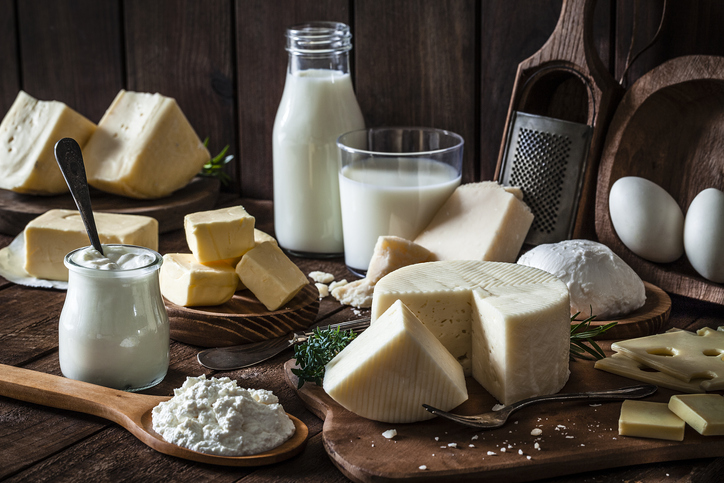Is it time to stop skimming over full-fat dairy?

Americans consume about 150 pounds of milk and eat nearly 40 pounds of cheese and 20 pounds of ice cream per person per year, according to data from the Department of Agriculture. Yogurt and butter intakes are lower, but growing. But should the dairy we’re consuming be low-fat or full-fat? That debate has become increasingly divisive, and for good reason: not all dairy is created equal.
Dairy fat and cardiovascular disease
Some of the most substantial dairy research has been done in the context of the Dietary Approaches to Stop Hypertension (DASH) diet, which has been shown, among other benefits, to reduce blood pressure and lower cholesterol, both risk factors for cardiovascular disease (CVD). Along with promoting heart-healthy fats and fiber-rich foods, the DASH dietary plan recommends two to three servings per day of low-fat or fat-free dairy, primarily from milk, yogurt, and cheese. The vitamin and mineral content in these items, plus protein compounds called peptides, are believed to play a role in protecting the heart. Probiotics in fermented dairy products, like yogurt, have also been shown to improve blood pressure, and have been associated with decreasing CVD risk.
More recently, however, research has suggested that dairy need not be stripped of its fat. Some studies have indicated full-fat sources may not play a role in CVD-related deaths, and might even be protective in some cases.
This is not a call to arms for butter. Though recent data did not show an association between dairy fats and CVD, certain types of dairy fat were still correlated with an increased overall risk of death. Eating high-fat dairy, like butter, has also been associated with an increased risk of dementia. A little butter on toast is likely fine, but more than a tablespoon a day may still be risky. Using butter as your main cooking fat is still not advisable.
Dairy fat and cancer
This issue becomes a little more complex when looking at dairy and cancer risk. Some research has associated higher-fat dairy sources with worse breast cancer survival rates, for instance.
The problem with these studies is that different types of dairy products often get lumped together, meaning full-fat yogurt, cheese, cream, and ice cream are treated as equals.
No one would claim whole-milk yogurt and cookie dough ice cream to be equivalent, and we should take care not to view them as such. In fact, some studies suggest that fermented dairy foods like yogurt may reduce cancer risk, but more information is needed to tell whether the type you choose matters.
Dairy fat and body weight
When it comes to weight, full-fat dairy has been correlated with a decreased risk of obesity. One possible reason is that the fat found in whole milk or a wedge of Brie helps with satiety. Intuitively, this makes sense too. If something has a richer flavor, you may need less of it to feel satisfied.
We now know that being too restrictive about dietary fat may not be a helpful strategy for maintaining a healthy weight, particularly if it does not feel sustainable. It’s also possible that individuals avoiding high-fat foods may be more likely to suffer from a restrictive dieting mentality, possibly contributing to weight-related struggles later in life.
Choose wisely if opting for full-fat dairy
At the end of the day we can rely on a little common sense: the type of full-fat dairy you choose likely matters. Prioritizing fermented sources of full-fat dairy may be the way to go. Having a little cheese — or better yet, some whole-milk yogurt — might even offer benefits in certain cases. Having them alongside fruit or nuts (rather than on a slice of pizza or sweetened with sugar) would be even smarter.
As for ice cream and butter? They have perks too, namely the pleasure that comes from eating them.

Nenhum comentário